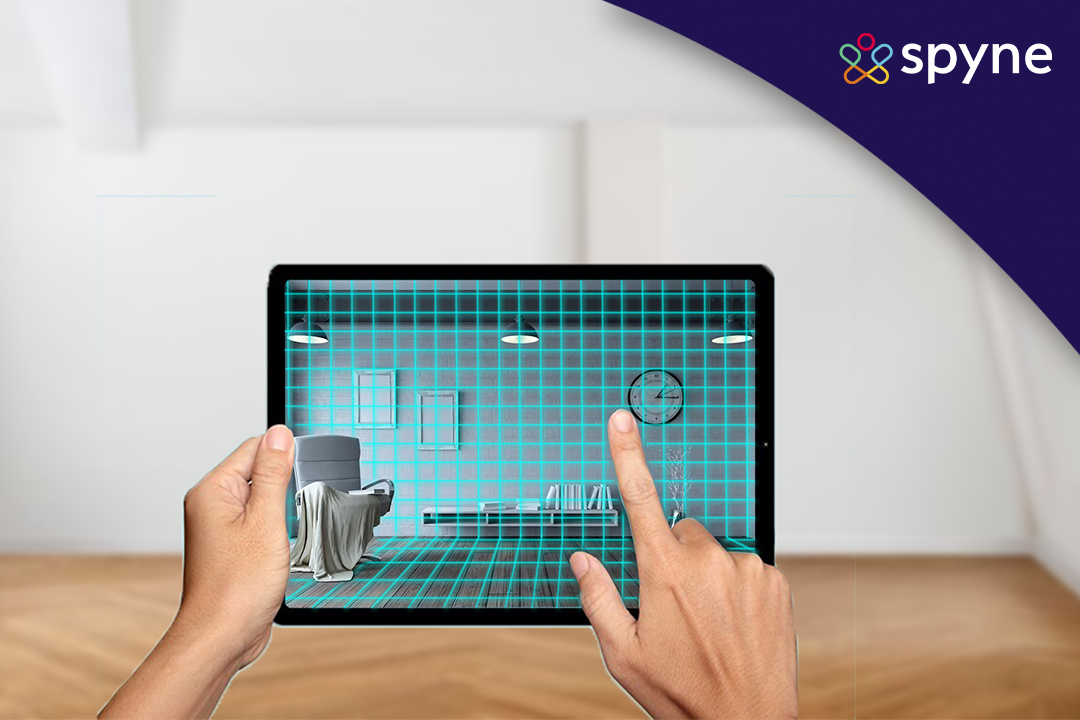As technology evolves, businesses seek new ways to improve the customer experience and increase sales. AR offers a unique opportunity to do just that by projecting digital data into the real world. Augmented Reality (AR) in business is a game-changer technology, potentially transforming operations and driving growth and competitiveness.
In this blog, we’ll explore the many benefits of integrating AR into your business strategy and how it can make you more profitable today. The possibilities for AR are endless, from sales and advertising to production and education.
Today, we’ll be delving into the exciting world of AR in business!
What Is Augmented Reality?
Augmented Reality (AR) is a technology that improves the real-world environment by overlaying digital information, such as graphics, sound, or GPS data, onto it. AR allows users to interact with the natural world while incorporating virtual elements into their surroundings. Augmented reality technology can be accessed using various devices, including smartphones, tablets, smart glasses, and head-mounted displays. AR technology’s ability to recognize and track real-world objects using cameras and sensors allows for the overlay of digital content onto them.
AR has applications in various fields, including gaming, education, advertising, and healthcare. Augmented Reality can enhance the user’s experience by providing additional information, improving learning outcomes, or providing a more immersive experience. AR is becoming increasingly popular, with many companies investing in AR technology to enhance their products and services.
Difference Between Augmented Reality and Virtual Reality
Augmented reality (AR) and virtual reality (VR) are different technologies in terms of the way they change the user’s perception of reality.
With Virtual Reality (VR), users can enter and fully engage with a wholly digital environment, while AR enhances the real-world environment by overlaying digital information.
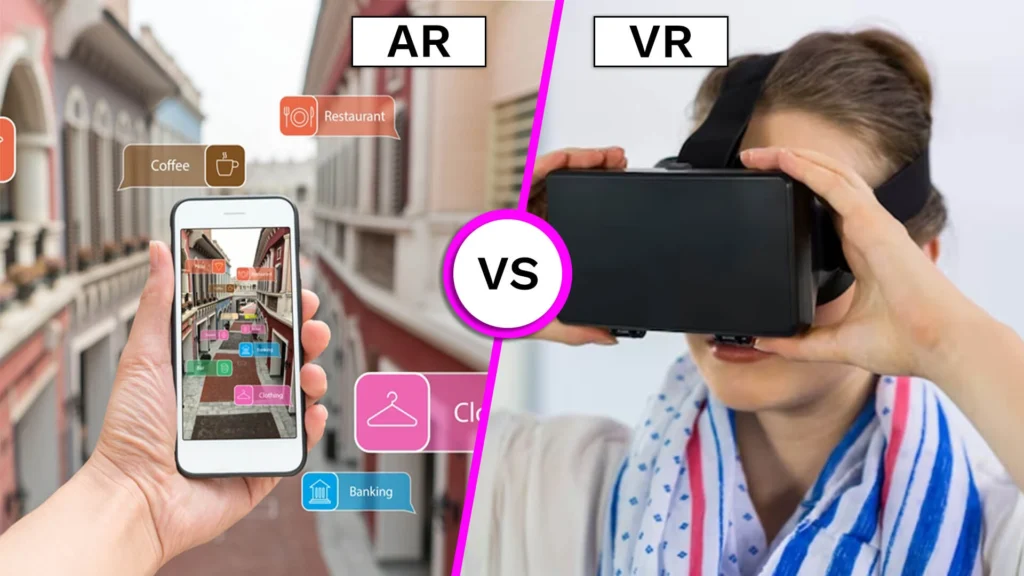
A Virtual Reality (VR) headset creates a total blackout of the real world, replacing it with a completely digital environment. In contrast, AR does not block out the real world but rather enhances it with virtual elements that are superimposed onto it.
AR is experienced through devices like smartphones, tablets, and smart glasses that use cameras and sensors to recognize and track real-world objects.
VR is commonly used for entertainment and gaming and training simulations for industries such as aviation and medicine. On the other hand, AR has a broader range of applications, including gaming, education, advertising, and healthcare.
In summary, while AR and VR in business enhance the user’s experience, they differ in terms of their level of immersion and the applications they are used for.
Augmented Reality Market Share
The global augmented reality (AR) market is predicted to be $12.8 billion by 2021 and is projected to grow to $72.7 billion by 2024, with a 44.5% CAGR during the period forecast.
The AR market is currently dominated by the gaming and entertainment industry, making up most of the overall market. But AR is increasingly used by other sectors such as healthcare, education, retail, and commerce, which is expected to support future growth.
Regarding geography, the largest market for AR is North America, followed by Europe and Asia Pacific. The United States is North America’s largest market, while Germany is the largest in Europe. The Asia-Pacific region has two largest economies: China and Japan. Analysts expect China to become the largest economy in the region by 2024.
Major players in the AR industry include Google, Apple, Microsoft, PTC, Qualcomm, and Samsung.
Why Every Organization Needs An Augmented Reality Strategy
Every organization needs an augmented reality (AR) strategy because AR has the potential to change the way businesses and customers interact. Here’s why:
Improve Customer Experience: AR can enhance the customer experience by providing a rich and interactive experience that increases engagement and loyalty. For example, Fashion stores are using AR to create virtual experiments, and electronics companies are using it for product discussions.
Increase Efficiency and Productivity: AR can increase efficiency and productivity in manufacturing, logistics, and healthcare industries. By combining digital information with actual equipment, employees can work faster and more accurately, reduce errors and improve quality.
Competitive advantage: AR can provide a competitive advantage by differentiating an organization’s products and services from its competitors. By using AR to create new and engaging experiences, companies can attract and retain customers and stand out in a crowded market.
Cost Savings: AR can reduce costs by enabling distance learning and support, reducing the need for travel and on-site training. It can also increase supply chain efficiency by providing real-time visibility and tracking inventory and shipments.
Innovation: AR can drive innovation by providing a platform for experimentation and creativity.
It can enable companies to explore new business models and revenue streams and create new opportunities for growth.
Augmented Reality (AR) In Business

Augmented Reality (AR) for businesses is a revolutionary technology that allows businesses to transform their interactions with customers and clients, enabling them to create engaging and immersive experiences. Companies can apply AR to various business operations, from enhancing product visualization to providing virtual training. By leveraging AR in businesses, they can differentiate themselves from competitors, increase brand awareness, and drive sales.
Why augmented reality in business?
Augmented Reality (AR) can transform businesses by providing new ways to interact with customers, employees, and products. With Augmented Reality (AR), businesses can offer customers a new level of engagement, providing immersive and interactive product demonstrations that allow for a better understanding of products. Increased engagement, satisfaction, and loyalty can result from this.
Augmented Reality (AR) technology can increase efficiency and productivity across various industries, including manufacturing, logistics, and healthcare. By overlaying digital information on real-world objects, workers can perform tasks more quickly and accurately, reducing errors and improving quality. Significant cost savings for businesses can result from this.
Amazon Product photography and augmented reality can be used to create an immersive shopping experience for customers. For example, a retailer could use high-quality product photography to showcase their products on their website and then use AR to allow customers to virtually place those products in their homes to see how they look and fit.
How Is Augmented Reality Used in Business?
AR can be used in business in many ways, including:
- Product Presentation and Visualization: AR for product presentation and visualization can be used to create an interactive and positive experience for customers, making it easier for them to understand and interact with the product.
- Training and support: Companies can use it to provide remote training and support to employees, thereby reducing the need for travel and on-site training.
- Manufacturing and logistics: Companies can use AR to improve operations and productivity by providing real-time information and advice to employees.
- Marketing and advertising: Businesses can use it to create collaborative and interactive strategies to attract customers and differentiate themselves from their competitors.
How Augmented Reality Benefits Businesses?
AR can provide many benefits for businesses, such as enhancing the customer experience, improving efficiency and productivity, providing cost savings, and driving innovation. Through Augmented Reality (AR), companies can create unique experiences that set them apart from competitors, attract customers, and build brand loyalty.
AR can also provide significant cost savings for businesses by reducing the need for travel, improving the accuracy and efficiency of tasks, and reducing errors and waste.
In addition to these benefits, AR can also drive innovation and help businesses explore new business models and revenue streams. Businesses can expand their offerings and increase revenue by creating new digital products and services or providing customers with new ways to engage with existing products and services.
How to Implement AR in Your Business Strategy?
Implementing augmented reality (AR) into your business strategy can help you engage with customers, enhance their experience with your products or services, and differentiate your brand from competitors. Here are some strategies to follow:
- Define your business goals: Find out how AR technology can help you accomplish your business goals, such as increasing sales, improving customer engagement, or enhancing brand awareness.
- Identify the target audience: Identify the target audience that will benefit from the AR experience, such as potential customers, current customers, or employees.
- Research AR solutions: Research AR solutions that fit your business needs and budget, such as AR mobile apps or glasses.
- Create AR content: Create AR content that is relevant to your business and provides value to the target audience. For example, you can use AR to showcase your products or provide virtual tours of your facilities.
- Promote AR experience: To attract your target audience to the AR experience, you can leverage social media, email marketing, or in-store displays, showcasing the benefits of the technology.
- Measure results: Track the results of your AR implementation, such as engagement rates, sales, or customer feedback. Use the data to optimize your AR strategy and improve the user experience.
The success of AR implementation depends on understanding your audience, creating relevant content, and delivering an exceptional user experience.
How to Implement AR in Your Business Step-By-Step?
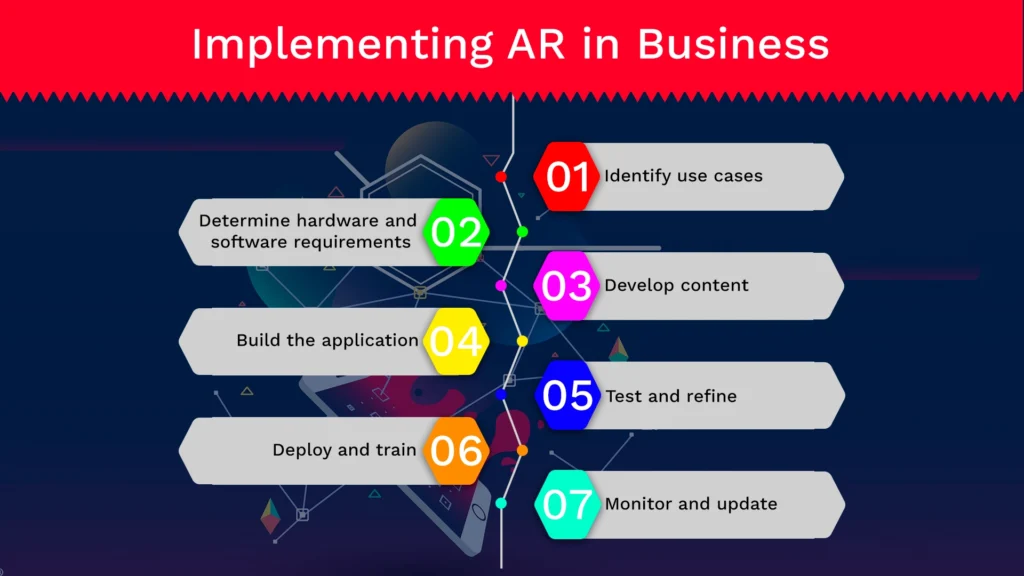
Here are the steps to implement AR in your business:
- Identify use cases: Identify potential use cases where AR could benefit your business. This could include training, product visualization, or customer experiences.
- Determine hardware and software requirements: Determine the hardware and software requirements for implementing AR. This could include AR headsets, smartphones, tablets, and AR software development kits or platforms.
- Develop content: Develop the content you need for your AR implementation. This could include 3D models, animations, or interactive elements.
- Build the application: Build the AR application using your chosen development tools and hardware. This may involve working with an external developer or building the application in-house.
- Test and refine: Test the AR application to ensure it functions correctly and delivers the desired results. Refine the application as needed to ensure it is meeting your business goals.
- Deploy and train: Deploy the AR application to the appropriate hardware and devices, and train users as needed. This may involve training employees or providing instructions to customers.
- Monitor and update: Monitor the performance of the AR application and make updates as needed to ensure it continues to deliver value and meet your business goals.
By following these steps, you can implement AR in your business and benefit from its benefits.
What Are the Advantages of Using Augmented Reality in Business?
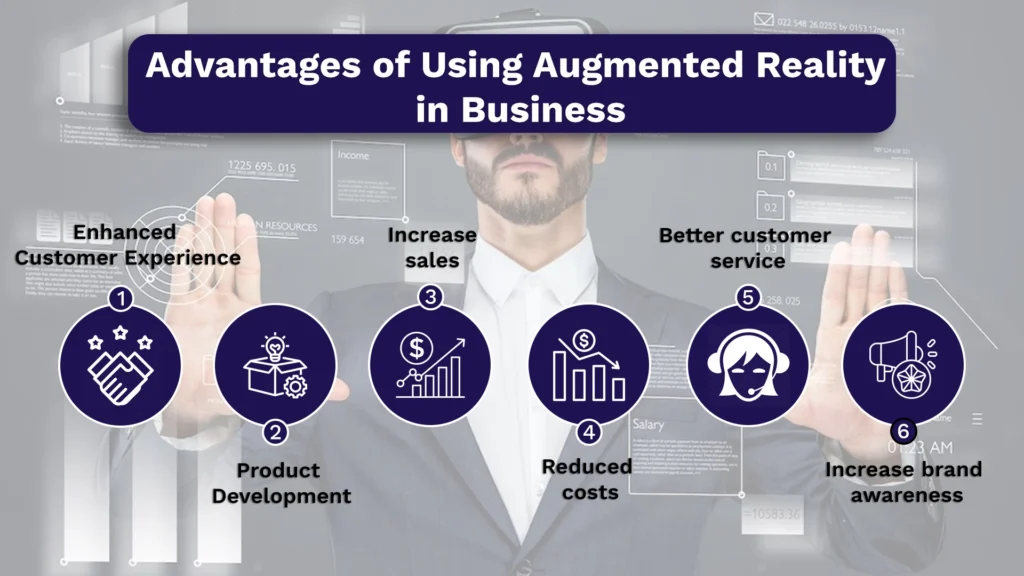
The following are the advantages of using Augmented Reality (AR) in business:
Enhanced Customer Experience: AR can provide customers with helpful, interactive experiences that enable collaboration and engagement. Customers can experience products in 3D, and AR can provide more excellent knowledge and understanding of products, increasing customer satisfaction and trust.
Product Development: With AR, businesses can deliver demonstrations allowing customers to see real products. This can increase sales by helping customers better understand the product’s features and features.
Increase sales: Using AR; businesses can create an engaging and unique customer experience that sets them apart from the competition. This can increase sales and profits.
Reduced costs: With AR, businesses can create product demos, reducing the need for expensive physical model shoots. Additionally, AR can reduce training costs by providing virtual training and education to employees.
Better customer service: With AR, businesses can provide customers with real-time information about products and services, enabling them to make informed decisions. In addition, AR can provide virtual support and assistance to customers, reducing waiting time and improving the customer experience.
Increase brand awareness: Using AR, businesses can create unique and memorable experiences that help increase brand awareness and recognition. This can lead to customer loyalty and feedback.
How AR May Change The Way We Work?
Augmented reality (AR) can change how we work in many ways. The ways AR can change the way we work are:
Increased productivity: AR can provide real-time information and guidance to employees, enabling them to work efficiently and accurately. For example, workers can use AR glasses to get step-by-step instructions on repairing machines, reducing the need for manuals or training.
Networking: AR can help teams work together remotely as if they were in the exact physical location. For example, using an AR headset, a team of employees can create and see things together, even if they are in different parts of the world.
Enhanced training: Augmented Reality (AR) technology can offer employees a highly effective training solution by providing opportunities to practice and learn in simulated environments. This is particularly useful for high-risk or complex operations such as surgery or aircraft maintenance.
Better customer experience: AR can improve the customer experience by delivering interactive and personalized content. For example, Augmented reality technology has made it possible for consumers to preview how furniture and home decor would look in their homes before making a purchase.
Safe workplace: AR can provide workers with real-time safety information and alerts. For example, AR glasses can warn workers of dangers or give instructions on responding to an emergency.
AR Impact On Different Industries & Real Use Cases
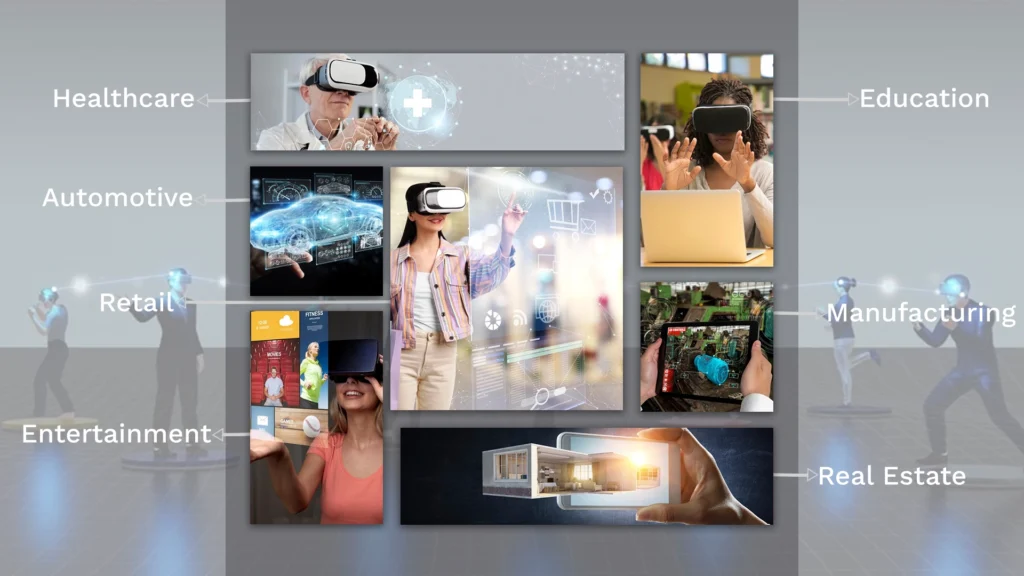
Augmented reality (AR) can transform many industries by enhancing customer experiences, improving productivity, and creating new business opportunities. Here are some examples of how various industries are using AR:
Retail: AR provides customers with virtual product demonstrations and try-on experiences. For example, IKEA’s AR app lets customers preview furniture in their homes before purchasing. The Virtual Artist app of Sephora uses AR to let customers try on makeup virtually.
Healthcare: AR enhances medical training, improves patient outcomes, and assists with surgical procedures. For example, the AccuVein device uses AR to help doctors locate veins for blood draws and IV placement. Medical trainers are using Microsoft HoloLens to simulate surgical procedures.
Education: AR is used in education to create immersive learning experiences and provide students with virtual field trips. For example, the Smithsonian American Art Museum’s AR app allows students to explore exhibits virtually.
Real Estate: AR is used in real estate to provide virtual property tours and visualizations. For example, Zillow’s AR app allows customers to view virtual home tours, while AR developer Magic Leap works on an AR platform for architecture and real estate.
Automotive:The automotive industry uses AR to provide drivers with real-time information and improve safety. For example, The AR HUD system from BMW displays essential information like speed and navigation directly onto the windshield, offering drivers a convenient and futuristic way to stay informed while keeping their eyes on the road.
Entertainment: Companies use AR to create interactive experiences and enhance performances. For example, Cirque du Soleil’s show “Toruk” uses AR to create a virtual world for the performers to interact with.
Manufacturing: Companies use AR to improve productivity and reduce errors. For example, Boeing uses AR to guide workers through complex assembly tasks, while GE uses AR to provide maintenance workers with real-time instructions.
Conclusion
The rapid advancement of AR technology is enabling businesses to improve their operations. It is also allowing them to interact with customers in novel and effective ways. This makes AR a valuable tool for enhancing customer engagement and driving innovation across various industries. From improving product visualization and employee training to enhancing restaurant marketing campaigns and providing immersive experiences, AR is revolutionizing how businesses operate and interact with customers.
The benefits of AR in business are undeniable. Companies and product photography services that embrace this technology will likely have a competitive edge in their industries. As AR evolves, we can expect to see even more creative and impactful applications.

